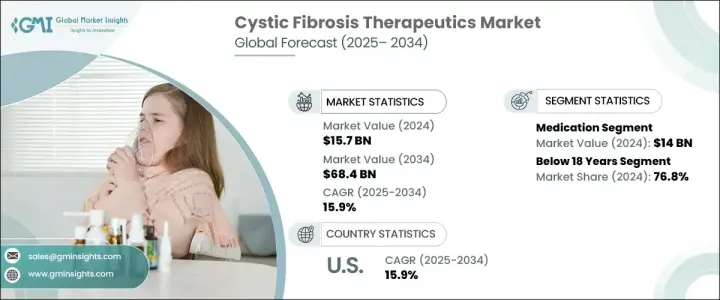
낭포성 섬유증 치료제 세계 시장 규모는 2024년 157억 달러로 평가되었고, 2025-2034년 15.9%의 연평균 복합 성장률(CAGR)로 성장할 것으로 예상됩니다.
낭포성 섬유증(CF)의 유병률 증가와 효과적인 치료 솔루션에 대한 관심이 높아지면서 시장 성장에 크게 기여하고 있으며, CF 환자 수가 증가함에 따라 조기 진단 및 개선된 치료 옵션에 대한 필요성이 높아져 혁신적인 치료법에 대한 수요가 증가하고 있습니다. 연구개발에 대한 투자로 잠재적 치료법, 특히 CFTR(CFransmembrane conductance regulator) 모듈레이터의 발전이 가속화되고 있으며, 임상시험 파이프라인이 확대되고 있습니다. 이러한 노력은 치료 효과를 개선하고 미충족 의료 수요를 충족시키기 위한 것으로, 시장 성장 기회를 확대하는 데 기여하고 있습니다.

세계 시장은 약물요법 및 비약물요법으로 나뉩니다. 약물요법 부문은 2023년 119억 달러로 평가되었고, 2024년에는 140억 달러의 수익을 창출할 것으로 예상되며, 예측 기간 동안 16.1%의 연평균 복합 성장률(CAGR)을 나타내고, 우위를 유지할 것으로 예상됩니다. 이 부문에는 CFTR 조절제, 기관지 확장제, 항감염제, 점액 용해제, 췌장 효소 보충제, 기타 약물이 포함되며, CF 약수처리, 특히 CFTR 조절제 및 기타 대증요법이 크게 발전하면서 수요가 증가하고 있습니다. 이러한 약물은 CF의 증상과 유전자 변이를 표적으로 하여 환자의 예후를 개선합니다. R&D 투자 증가로 인해 치료 옵션은 계속 증가하고 있으며, 이는 시장에서 이 부문의 입지를 강화시키고 있습니다. 개인맞춤형 의료의 확대와 폭넓은 보험급여 지원도 이 분야의 성장을 가속하는 주요 요인으로 작용하고 있습니다.
| 시장 규모 | |
|---|---|
| 시작 연도 | 2024년 |
| 예측 연도 | 2025-2034년 |
| 시작 금액 | 157억 달러 |
| 예상 금액 | 684억 달러 |
| CAGR | 15.9% |
연령대별로는 18세 미만, 18-40세, 41세 이상으로 구분되며, 2024년에는 18세 미만 부문이 76.8%로 가장 큰 시장 점유율을 차지할 것으로 예상됩니다. 소아 및 청소년의 CF 발병률이 높기 때문에 조기 진단 및 표적 치료에 대한 수요가 증가하고 있습니다. 대부분의 경우, 어린 시절에 발견되기 때문에 신속한 개입과 전문적인 치료가 필요합니다. 개선된 진단 도구와 혁신적인 치료법에 대한 접근성이 증가하고 있는 것도 이 분야의 성장을 가속하고 있습니다. 소아과 의료에 대한 연구와 규제 당국의 승인도 예측 기간 동안 계속 우위를 확보하는 데 중요한 역할을 할 것으로 보입니다.
미국은 2024년 북미 낭포성 섬유증 치료제 시장에서 큰 점유율을 차지하여 2023년 89억 달러에서 2024년 105억 달러로 15.9%의 연평균 복합 성장률(CAGR)을 나타낼 것으로 예측됩니다. CF의 높은 유병률로 인해 효과적인 치료법에 대한 수요가 증가하고 있으며, 질병 부담을 관리하기 위한 강력한 R&D 이니셔티브가 뒷받침되고 있습니다. 특히 CFTR 조절제와 첨단 치료제의 경우 정부 및 민간 부문의 풍부한 자금 지원으로 의약품 개발의 혁신이 계속되고 있습니다. 새로운 제제를 통한 치료 옵션의 확대는 시장 성장을 더욱 촉진하고 있습니다. 강력한 상환 정책과 주요 기업의 존재는 이 시장에서 한국의 지속적인 리더십에 기여하고 있습니다.
The Global Cystic Fibrosis Therapeutics Market was valued at USD 15.7 billion in 2024 and is projected to grow at a CAGR of 15.9% from 2025 to 2034. The increasing prevalence of cystic fibrosis (CF) and the rising focus on effective treatment solutions have contributed significantly to market growth. The growing number of CF cases has heightened the need for early diagnosis and improved therapeutic options, driving demand for innovative treatments. Research and development investments have accelerated advancements in potential therapies, particularly CF transmembrane conductance regulator (CFTR) modulators, leading to an expanding pipeline of clinical trials. These efforts aim to enhance treatment effectiveness and address unmet medical needs, broadening growth opportunities in the market.

The global market is segmented into medication and non-medication categories. The medication segment, valued at USD 11.9 billion in 2023, is projected to generate USD 14 billion in revenue in 2024. It is expected to maintain its dominance throughout the forecast period, growing at a CAGR of 16.1%. This segment includes CFTR modulators, bronchodilators, anti-infective agents, mucolytic agents, pancreatic enzyme supplements, and other drug classes. The growing advancements in CF drug therapies, particularly CFTR modulators and other symptomatic treatments, have significantly boosted demand. These medications improve patient outcomes by targeting CF symptoms and genetic mutations. Increasing research and development investments continue to enhance treatment availability, strengthening the segment's position in the market. The expansion of personalized medicine and broader reimbursement support are also key factors fueling segment growth.
| Market Scope | |
|---|---|
| Start Year | 2024 |
| Forecast Year | 2025-2034 |
| Start Value | $15.7 Billion |
| Forecast Value | $68.4 Billion |
| CAGR | 15.9% |
Based on age group, the market is divided into Below 18 years, 18-40 years, and 41 years and above. In 2024, the Below 18 years segment held the largest market share at 76.8%. The high occurrence of CF in children and adolescents has driven demand for early diagnosis and targeted therapies. Most cases are identified in early childhood, necessitating prompt intervention and specialized treatments. Growing access to improved diagnostic tools and innovative therapies further reinforces segment growth. Pediatric research and regulatory approvals also play a crucial role in ensuring continued dominance throughout the forecast period.
In 2024, the United States held a significant share of the North American cystic fibrosis therapeutics market, generating USD 10.5 billion, up from USD 8.9 billion in 2023, with a CAGR of 15.9%. The high prevalence of CF in the country has fueled the demand for effective treatments, supported by strong research and development initiatives aimed at managing the disease burden. Extensive funding from both government and private sectors continues to drive innovations in drug development, particularly in CFTR modulators and advanced therapies. Expanding treatment options through novel drug formulations further boosts market growth. Strong reimbursement policies and the presence of leading pharmaceutical companies contribute to the country's sustained leadership in the market.